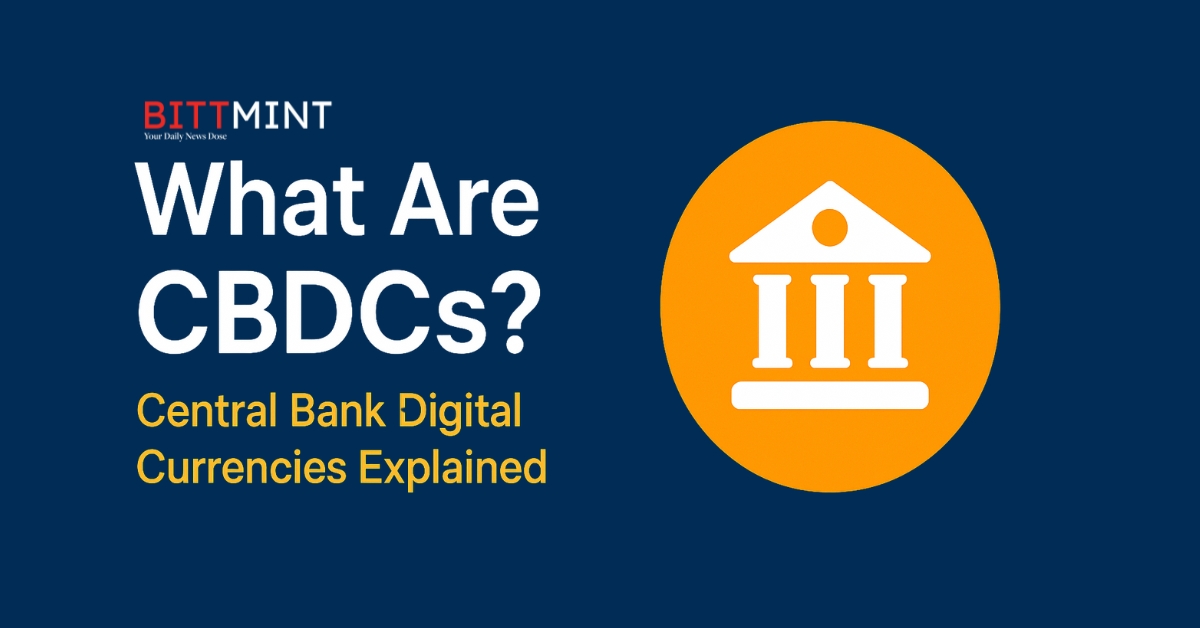In recent years, governments around the world have started exploring something called CBDCs short for Central Bank Digital Currencies. If you’re new to the crypto or finance world, this might sound confusing. Our BittMint editorial team have break it down in simple words.
What Is a CBDC?
A CBDC is a digital version of a country’s official currency, issued and regulated by its central bank. It’s just like regular cash (rupees, dollars, euros), but completely digital.
Unlike cryptocurrencies like Bitcoin or Ethereum, which are decentralized and not backed by any government, CBDCs are fully centralized, state-backed, and tied to a country’s monetary policy.
Think of it this way:
- Regular money = physical notes and coins
- Digital payments = money in your bank app (but it’s still private bank money)
- CBDCs = digital currency directly issued by the central bank
Why Are Countries Developing CBDCs?
There are several reasons why governments are rushing to create CBDCs:
- Digital Economy Push: Cash usage is declining, and governments want a secure, controlled way to digitize payments.
- Faster & Cheaper Transactions: CBDCs can reduce the cost and time of transferring money, especially across borders.
- Financial Inclusion: In countries where people don’t have access to banks, CBDCs could allow them to use just a smartphone.
- Combat Illicit Use of Cash: Digital money can be traceable, reducing black money and fraud.
- Respond to Crypto Growth: CBDCs give governments a way to stay relevant in a world dominated by crypto and stablecoins like USDT and USDC.
Who Is Working on CBDCs?
As of 2025, over 130 countries are exploring or developing CBDCs. Some notable examples:
- India: Launched the e₹ (Digital Rupee) pilot program via the Reserve Bank of India (RBI).
- China: Far ahead with the e-CNY (Digital Yuan), already in public trials across cities.
- Europe: The European Central Bank is testing the Digital Euro.
- USA: Exploring a Digital Dollar, but progress is cautious.
Even smaller nations like the Bahamas have fully launched CBDCs like the Sand Dollar.
How Do CBDCs Work?
CBDCs are stored in digital wallets — either on your smartphone or through a bank. They can be:
- Retail CBDCs: For the general public (like e₹ for you and me)
- Wholesale CBDCs: Used between banks and financial institutions
They use secure technologies like blockchain or centralized ledgers, depending on the country’s approach. But unlike crypto, the central bank controls everything that includes issuance, privacy levels, and tracking.
Will CBDCs Replace Cash or Crypto?
Not entirely. CBDCs are meant to complement physical cash, not replace it — at least for now. And they are very different from Bitcoin or DeFi, which are private and borderless.
CBDCs could bring more stability and trust to the digital money world, but they come with questions about privacy, surveillance, and centralized control.
Final Thoughts
CBDCs are the future of government-issued money. They combine the efficiency of digital payments with the security of central bank backing. While there are still many questions to answer, CBDCs are slowly becoming a global financial trend you can’t ignore.
Whether you’re a crypto enthusiast or just getting into digital finance, understanding CBDCs will help you navigate the fast-changing world of money.
Resources used – Investopedia, Wikipedia & Crypto world news
